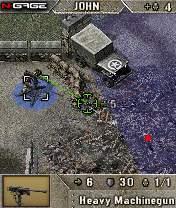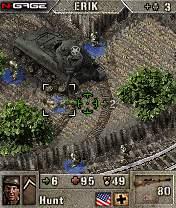Nokia's World War II-themed strategy game Pathway to Glory stands out immediately by being one of the few games specifically developed for the N-Gage that was designed to cater to the strengths of the device, connectivity and all. As promised, Pathway to Glory's WWII-themed, turn-based action translates well to Bluetooth and GPRS-powered multiplayer sessions. Some unfortunate technical issues prevent the cell network mode from working as well as it was probably intended, but with presentation and execution rivaling that of its PC influences, Pathway to Glory is a turn-based strategy game that stands out as one of the best the N-Gage has to offer.

Pathway to Glory puts you in control of several soldiers, each with specific stats. These are a loyal bunch that will follow you from mission to mission throughout your campaign, assuming, that is, you don't let them die. The more combat experience a unit gains, the more powerful he will become. Your coalition of the willing hails from a variety of nations, and each member of your war party unleashes a mighty battle cry in the appropriate language.
Before each mission, you'll be dramatically briefed via a well-acted voice-over that's set to an enervating musical score. Next you'll be presented with a dutifully researched historical background on the operation. This explains the importance of your current operation in the context of the war, and it compares the mission to what actually took place.
The game begins in 1943. At this point, the Americans are finally driving the war effort, having suffered the devastating Pearl Harbor attack two years earlier. Pathway to Glory concentrates on the European battlefront, beginning with the coastal invasion of Sicily, and ending with the French's penetration of the Beffort Gap. This was the event that began the Allied invasion of Germany, which apparently really ticked off Hitler, who, during this period, would frequently take long walks alone. Pathway to Glory's campaign is long and satisfying, and is more than just a tutorial for online play.
Each operation takes place on a well-rendered map that's a faithful representation of whatever picturesque village you happen to currently be destroying. Level design is the major strength of Pathway to Glory, because each battleground has been carefully designed to foster strategic play. You'll really have to study the cover offered by each map to succeed. Pathway to Glory's enemy intelligence is also formidable. Although the opposing units won't really work as a team, they use their environment well, and will stake out positions on high ground, where your chances of hitting them are lessened. Enemy soldiers will fight you tooth and nail, provided you're in their range of vision. But if you can sneak up behind them, they'll be powerless to stop your onslaught.
Your soldiers have a variety of authentic weapons at their disposal. How much they're packing will affect how far they can move in a turn. Consequently, although you'll primarily be dealing with infantry, each unit is differentiated based on its particular arsenal. A weapon's range can be extended by assuming crouched or prone positions, which, incidentally, will also reduce the degree to which your units are exposed to hostile fire. Your units will expend far more energy to move in to these positions, however. This simple feature adds a great deal of depth to the game, because it forces you to consider whether to play offensively or defensively, and it allows you to put your environment to better use.
Vehicular combat is also an important element of play. It's also extremely fun. Your units can be instructed to hop into a tank or jeep. The tank limits movement but increases firepower, while the jeep does the opposite. Capitalizing on the presence of these vehicles is vital, both in the single-player campaign and in multiplayer sessions, where you and your opponent will often have access to the same vehicles on either sides of the map.
Yes, Pathway to Glory features real, honest-to-goodness multiplayer. You won't be downloading "ghost" movies of a rival's performance; instead you'll actually be playing against real people in a live, turn-based setting. Over Bluetooth, this works flawlessly. Matches are intense and rewarding.
Online is a different story. To connect to N-Gage Arena, you'll have to first make an account, which requires filling out several pages of form data. If you've already used the Arena service, you'll be able to use your old account information. Next, you'll connect to the game lobby, where you'll be able to post to the technical support forum, which is likely well-trafficked. Then you'll change profile options or enter Arena's matchmaking service, which will attempt to connect you with one or more opponents. Often, your connection will drop out here, regardless of coverage. If you succeed in joining the game, however, you'll be able to do some neat stuff, like chat with your allies via recordable three-second voice clips. The time you can take in a turn will be limited so that inattentive players can't slow down the game for everyone else. Unfortunately, turns still take too long, so you'll be doing a lot of idling, especially during six-player confrontations. One wonders how the twenty-five man sessions Nokia originally promised would have worked within the context of this gameplay model.
Furthermore, connections are often mysteriously lost when you first engage an opponent. We encountered this problem on multiple N-Gages with different GSM providers. Occasionally, an apparent server error would keep us from connecting at all. Adding to the frustration is the fact that, should you be kicked out of a game session, you'll likely also be ejected from Arena itself, meaning you'll need to re-login.
If online play works, and if you accept it for the plodding, slow-paced fare it is, there's a lot of enjoyment to be had. Most won't be willing to stomach the frustration of frequent lost connections, however. Additionally, it takes an absurdly long time to reconnect to a game. While the game's GPRS play can't yet be regarded as an outright failure for Nokia, because the company's likely still working to improve Arena's stability, its glitches are extremely disappointing.
With online currently something of a wash, the question then becomes whether Pathway to Glory can stand on the merit of its single-player and Bluetooth multiplayer offerings. The answer is a resounding yes. From both gameplay and presentation standpoints, Pathway to Glory is an excellent entry in the military strategy pantheon.

Pathway to Glory's presentation is also terrific. Every aspect of the audiovisual production evokes the appropriate atmosphere--from the slideshow cinematics set to mournful music, to the sad beauty of gutted Sicilian siege towns. The in-game artwork looks very similar to that of Eidos' Commandos series (which isn't a bad thing), and those all-important explosions sound as great as the game's haunting violin overture. Nokia has billed this game as a technical showcase for the N-Gage, and it is just that.
While the promise of true online play remains somewhat unfulfilled, Pathway to Glory is still a compelling turn-based strategy offering. With any luck, Nokia will work out the kinks and make the game playable over GPRS. However, even without the feature, there's great action here.